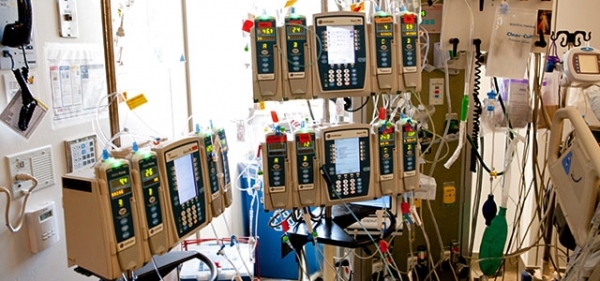Battling Alarm Fatigue: Nursing School Leads Research on Rising Problem in Hospitals

Talk about the dangers of multitasking.
“You’re in sterile garb with a patient, and in the next room an alarm goes off. You have to decide if it’s a bed alarm, a ventilator alarm or something else – you need to memorize those sounds and most monitors have multiple sounds. You have to make a decision about whether it’s a technical problem or something more serious, and then you have to decide if and how quickly you need to respond,” says Barbara Drew, RN, PhD, an internationally recognized cardiac monitoring expert who is a professor in the critical care/trauma program at the UCSF School of Nursing and in the Division of Cardiology at the UCSF School of Medicine.

Barbara Drew, RN, PhD
The decision points she describes are disturbingly frequent, especially in intensive care units (ICUs), where nurses might hear over a hundred alarms an hour, many of them false positives.
There is a lot at stake in these complex interactions among people, processes and technology that lead to what has come to be known as alarm fatigue: where clinicians turn down, turn off or tune out the alarms because they are exhausted by their frequency and the number of times they are false. Awareness of the dangers is rising fast around the country.
In one highly publicized case in Pennsylvania, the muting of an alarm cost a teen her life and the surgery center a $6 million malpractice settlement. According to a recent article in the Washington Post, over a three-and-a-half-year period ending June 2012, the Joint Commission had reports of 98 alarm-related incidents, including 80 deaths; in more than 60 percent of the cases, alarms were either inappropriately turned off or were not audible in all areas.
The commission believes the reports, which are voluntary, do not begin to tell the whole story and has established a national patient safety goal on alarms that goes into effect in 2014.
Along with colleagues at UCSF Medical Center and nursing schools that include Johns Hopkins and Yale, Drew is among a small group of nurse scientists conducting research to inform emerging regulations and processes and, ultimately, solve the problem.
At the moment, her collaborative project with GE Healthcare is designed to characterize every piece of clinical information ICU alarms deliver so device manufacturers have the data they need to create better, smarter alarms.
She cautions, however, that the solutions go beyond better technology. “This is a multifactorial problem – technology, nursing practice and systems – and we have to approach it from all of those angles,” says Drew.
